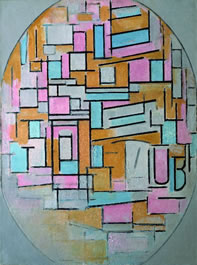|
Throughout his lifetime Piet Mondrian moved back and fourth from Holland to Paris onto to London
and finally New York, moving either because of his need to place himself within a certain social
complexity that would evidently also change painting style, or moving because of the threat of
foreshadowing war thru both WWI and WWII. Along his way he acquired a language of many styles,
evolving his own work with an incredible lineality. Learning to paint in a style of lassic Dutch
realism, he painted portraits, still life’s, and naturalist landscapes. He learned new styles with
incredible speed and understanding, often painting better than his colleagues and even masters.
His work quickly moved thru luminist, and divisionist phases to abstract expressionist, pointillist,
and cubist,finally ending with his well-known primary colored neoplastic phase, or new image phase.Mondrian was also a very eloquent writer, and visionary, writing several articles on his
theories of the combining of all the arts. He wrote of a new world where all the arts including: painting,
sculpture, architecture, music, theater would combine as one entity called the new image, the neo-plastic
(neoplasticism). He was partly responsible for creating De Stijl (the style) magazine, a collective of
mainly artists and architects who wanted modernism to become a well-known international idea and practice.
Mondrian’s work would help from design schools such as the Bauhaus, and end up having a tremendous effect
on the arts from graphic design to fashion and architecture.
|




